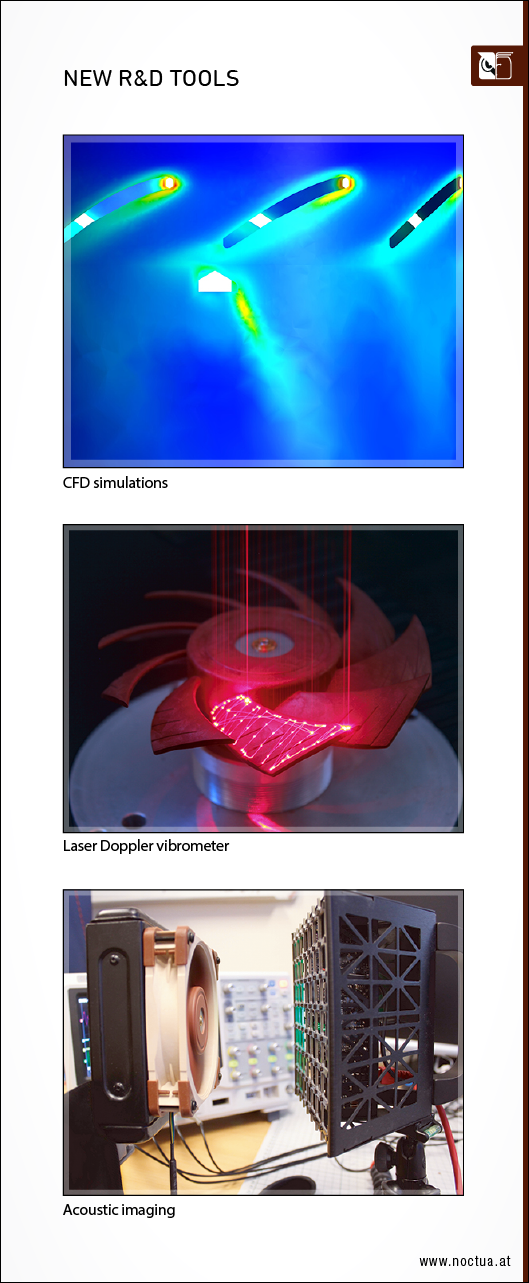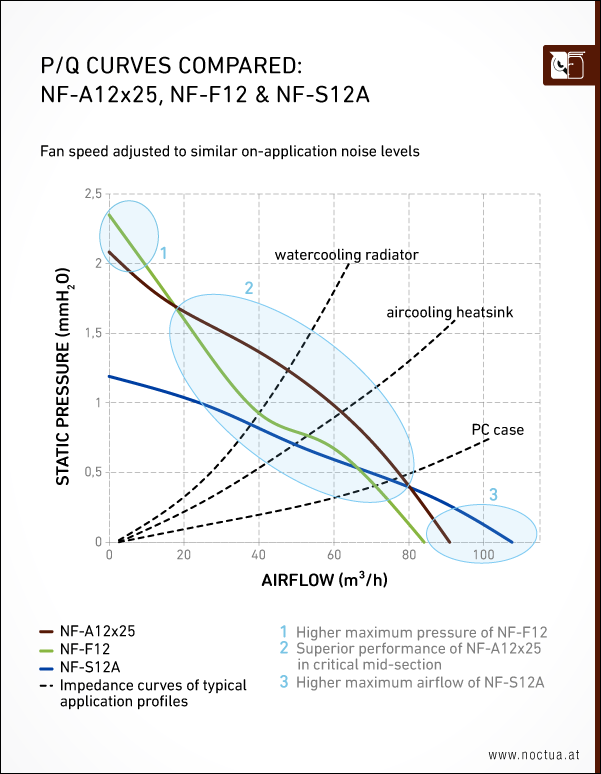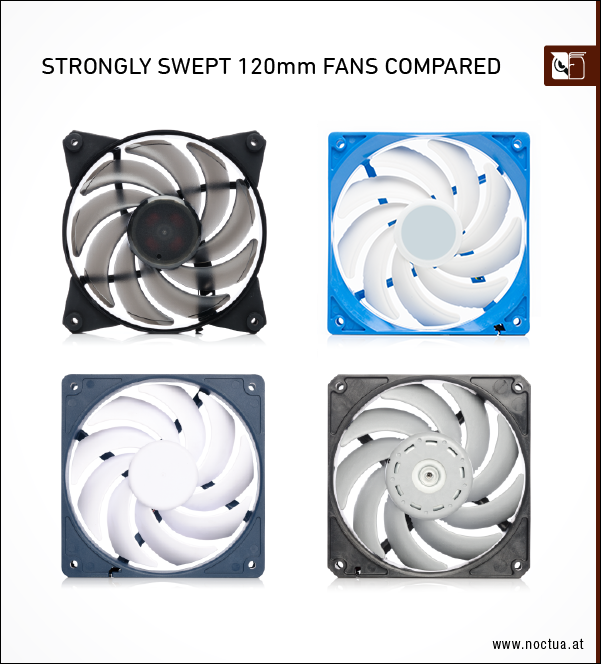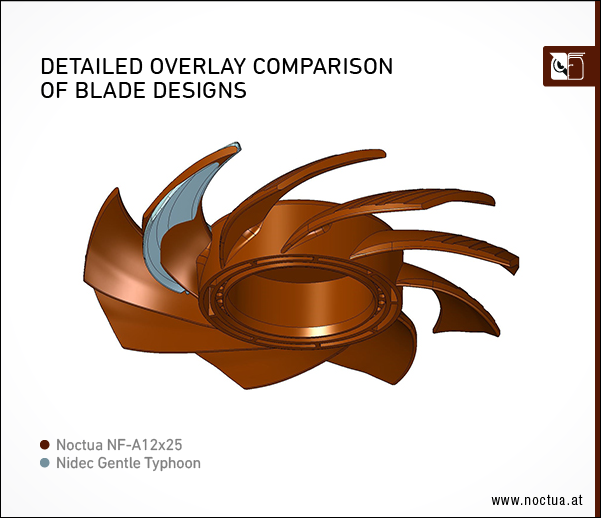NF-A12x25: interview with Lars Strömbäck (Noctua CTO)
Interview with Lars Strömbäck (Noctua CTO) about the development of the NF-A12x25 fan
Noctua-News: How long did it take to develop the NF-A12x25 fan? What makes it so special for Noctua?
Lars Strömbäck (Noctua CTO): The NF-A12x25 has been our longest and most complicated fan development project ever. It has taken us more than 4 years to complete and prompted us to step up our game both in R&D and manufacturing. In order to overcome the various challenges in design and manufacturing, we have significantly expanded our methodologies. For example, we are now using additional state-of-the-art measurement technology, have established a completely new measurement protocol and have developed the new Sterrox® liquid-crystal polymer compound. All of this and all the knowledge gained throughout the project will also contribute to other projects, so we’re not only excited to finally have this fan on the market but we’re also psyched with the new perspectives we’ve gained for future developments.
Noctua-News: This sounds exciting. Can you give us more details or examples regarding the new R&D tools?
Lars Strömbäck (Noctua CTO): For example, we’ve recently started using a new acoustic imaging device that allows us to map noise to images. This way, we can actually see where each type of noise originates from on the fan blades and on the fan frame. This has proven particularly helpful for fine-tuning the design for a frequency spectrum that sounds as pleasant as possible to the human ear. Now that we can directly visualise where undesired tonal frequency spikes are being caused, it’s much easier to tackle them on a design level. We’ve also started using laser Doppler vibrometers for contactless vibration measurement. This has turned out to be a key factor in tackling minute blade surface mode vibrations that can cause undesired resonance noises. It’s very hard to measure these things with traditional sensors because when you put them on the fan blades, the mass of the sensors will influence the way the blades respond to vibrations, so you will end up with skewed results. By contrast, the new contactless laser measurements allow us to work on a micro-level that would have been completely obscured by the mass of traditional vibration sensors in the past, so we can do much more fine-tuning on this front now.

Noctua-News: When you look at the airflow, pressure and noise specifications of the NF-A12x25, it seems that it covers the middle ground between the pressure-optimised NF-F12 and the airflow-optimised NF-S12A. Is this correct? Will all three fans remain in the line-up?
Lars Strömbäck (Noctua CTO): It’s natural to get this impression when looking at the specifications, but it’s not entirely correct. It’s true that at similar free flow sound pressure levels, the NF-F12 features a higher maximum pressure specification and the NF-S12A features a higher maximum airflow specification than the NF-A12x25. However, you have to take into consideration what these specifications actually mean and that they only have a very limited relevance for real-world applications. Simplifying things a bit, you can imagine the maximum pressure measurement as a situation where a fan is put blowing against a closed wall and the maximum airflow measurement as a situation where the fan is operating in completely free air rather than blowing onto or into something. Neither of the two situations commonly occurs in real-world applications where you usually have the fan working against some resistance, but never 100% resistance or zero resistance. So first off, you actually have to look at the entire pressure vs airflow (P/Q) curve of the fan to get a rough idea about its performance, and if you do this with the NF-A12x25, you will see that while it doesn’t excel at maximum pressure or airflow, it has an extremely strong mid section. This allows it to outperform both the NF-F12 and the NF-S12A in most typical applications. Secondly, you should keep in mind that the situation is similar with noise specifications: while they are given in a completely free flow scenario, what actually counts is how the fan sounds once you install it in your case, on your cooler or on your radiator and many users have had the experience that a fan that sounds nice in free flow can sound much more irritating on-application. This is why we spent a lot of extra time fine-tuning the NF-A12x25 for optimal on-application acoustics. So the bottom line of all this is that airflow, pressure and noise specifications only tell you so much and that in most applications, you will see superior results with the new NF-A12x25 as compared to NF-F12 and NF-S12A.

Noctua-News: So will all three fans remain in the line-up?
Lars Strömbäck (Noctua CTO): Yes. Although we’re confident that NF-A12x25 is the best choice for virtually any application, NF-F12 and NF-S12A are still excellent, proven fans and will remain in the line-up. Tens of thousands of users are very satisfied with these models and probably want to keep buying them. Also, while we’re positive that the NF-A12x25 is our best 120mm fan to date, it is also the most expensive. Unfortunately, our novel Sterrox® material used for the impeller is roughly four times more expensive than the fibre-glass reinforced PBT that we use for fans like the NF-F12 or NF-S12A. The NF-A12x25 also features a steel reinforced motor hub and extra brass reinforcements on the axis; plus manufacturing is more expensive due to the much tighter tolerances. Unfortunately all these measures add up to the production cost.
Noctua-News: Could you explain why it was necessary to take all these extra steps for the NF-A12x25?
Lars Strömbäck (Noctua CTO): Put in a nutshell, all this is necessary because we have chosen an extremely narrow tip clearance and the phenomenon called impeller creep: whereas the distance between the blade tips and the frame is above 1mm for most 120mm fans, we went for 0.5 with the NF-A12x25. Due to the centrifugal forces and tensions inside the plastics, fans will become slightly larger over years of usage. While this isn’t a problem as long as the gap between the frame and the blades is big enough, it’s highly critical when you go for such a small tip clearance and this is why we need much, much more precision when manufacturing the NF-A12x25. Any minute amount of creep, deformation or imbalance would be fatal.
Noctua-News: What’s the point of using such a small tip clearance? Is it really worth the extra effort?
Lars Strömbäck (Noctua CTO): *laughs* Well, it has taken us more than one year just to sort out the manufacturing issues, so there were times when we were wondering if it’s actually worth the extra effort, but at Noctua, we always strive to push the boundaries and deliver the best solution that’s technically possible. We’re confident that our customers appreciate this and that’s what’s justifying the effort for us in the end. Technically speaking, the reason why you want to go for such a tight tip clearance is that when the fan operates against back pressure, such as on a heatsink or radiator, some air will flow back through the gap between the blades and the frame. The smaller the gap, the less of this type of leak flow you have, so narrowing down the gap helps a great deal in achieving superior performance on heatsinks and radiators.
Noctua-News: The NF-A12x25 looks completely different than any previous Noctua 120mm fan. Why is this the case and how does the basic design approach compare to popular models like the NF-F12 or NF-S12A?
Lars Strömbäck (Noctua CTO): Yes, we have taken a completely different approach with the NF-A12x25. We’ve opted for a nine-blade design with strong curvature and sweep. The basic blade geometry builds on the insights we’ve gained with the other A-series models and, like with them, the goal was to achieve exceptional quiet cooling performance in just about any given application, regardless of whether it’s in a PC case or on a radiator. The NF-F12 and the NF-S12A, by contrast, are very specifically focused towards either high static pressure for radiators and heatsinks in the case of the NF-F12 or maximum airflow for chassis ventilation in the case of the NF-S12A. They are very dedicated solutions whereas the NF-A12x25, like the other A-series models, is a true all-rounder. This doesn’t mean that it’s a compromise though, quite the contrary. Thanks to all our latest technologies, the NF-A12x25 actually outperforms the NF-F12 on radiators by a healthy margin and performs at least as well as the NF-S12A when used as a case fan.
Noctua-News: When the NF-A12x25 was shown at the Noctua booth at Computex 2017, some visitors had the impression that, at first sight, it looks quite similar to some competitors’ products such as the Nidec Gentle Typhoon. Can you comment on that?
Lars Strömbäck (Noctua CTO): There are similarities to other fans as far as the basic approach of using a strongly curved and swept nine-blade design is concerned and this indeed makes them look somewhat similar at first sight. That’s quite natural because this basic approach is one of the most promising, proven starting points if you want to develop a high-performance 120x25mm form factor fan that is meant to achieve a strong, stable P/Q curve. If you look at it in more detail though, the similarities quickly come to an end and it becomes clear that the NF-A12x25 is significantly different from any other fan on the market as far as key factors such as the specific blade geometry and profile, chord length and changes in curvature are concerned. Once you map 3D CAD files of the NF-A12x25 over those of e.g. the Nidec Gentle Typhoon, this becomes immediately obvious. In detail, the blade design is completely different and these details are precisely the points that require so much R&D work to get right and to fine-tune for maximum efficiency. You can think of aeroplanes for reference: an Airbus 380 might look quite similar to a Boeing 747 to laymen at first sight and they are indeed similar in many ways (low wing design, swept blades, 4 jet engines, fuselage-mounted tailplane, etc.) for the natural reason that they have been designed for a similar purpose, but as soon as you start comparing in more detail, you will see how different the particular engineering choices have been. It’s similar with the NF-A12x25: it may look similar to other fans at first sight, but it’s a completely new design from the ground up.


Noctua-News: Have you analysed how the NF-A12x25 performs in comparison to other fans that look similar at first sight?
Lars Strömbäck (Noctua CTO): Whenever we develop a new fan, our goal is to provide the best performance-to-noise efficiency on the market, so we inevitably have to take a close look at what the market has to offer. The results actually reinforce the point I have just made: there are several models from different manufacturers that look quite similar at first sight, but there are vast differences in performance. This is because it’s the details and the fine-tuning of these details that make a good fan, not just the basic design approach. Of all the fans that could be considered looking similar to the NF-A12x25, the Nidec Gentle Typhoon proved to be the hardest competition, but we’re confident that our design is slightly superior. In our tests on a typical 2 inch all-in-one water cooler at 200W heatload with both fans adjusted to the same noise level, the NF-A12x25 with the supplied radiator gasket provided about 0.3 to 0.6°C lower temperatures than the Nidec depending on the speed settings. At the same time, our premium grade SSO2 bearing runs virtually inaudibly whereas the Nidec’s ball bearing produces an unpleasant tone that becomes clearly audible at lower fan speeds. Last but not least, unlike the NF-A12x25 with its integrated silicone pads and gasket, the Nidec doesn’t have an anti-vibration mounting and thus transmits vibrations and resonances to the radiator and case. All things considered, we’re confident that the NF-A12x25 is the best 120mm fan currently available.
Noctua-News: In addition to the different blade design, it seems that the NF-A12x25 has a slightly different shade of brown and a different surface texture as compared to other Noctua fans. What’s the reason for this?
Lars Strömbäck (Noctua CTO): Yes, the texture you can see on the impeller is the glass fibre reinforced crystal structure of the Sterrox® LCP material. The new material is very difficult to colour in general and the reinforced crystal structure will always shine through a bit, so it appears a bit more textured as compared to the smooth colour of our PBT- or PA-based fans. Adding colour particles changes the physical properties of the material and, as I’ve already explained, we need extreme precision for manufacturing the NF-A12x25, so our possibilities for colouring are somewhat limited. The colour we went for in the end is what gave us the best results from the technical side while still being easily recognisable as a Noctua fan. It’s slightly different compared to our usual shade of brown, but in the end we think it’s actually nice that users can immediately see that this is a novel, different material. In a way, this helps to visualise all the research and effort that went into making this fan.
Noctua-News: One more thing that appears slightly different with the NF-A12x25 is the Inner Surface Microstructures. They seem to be much smaller as compared to previous models. Is there a particular reason for this?
Lars Strömbäck (Noctua CTO): Yes, this is correct. Due to the tip clearance being so much smaller on the NF-A12x25, we only need a much thinner boundary layer on the inside of the frame to achieve the desired aerodynamic effect of the blade tips moving within this boundary layer in order to reduce vortex shedding from the tips of the blades. This is why the Inner Surface Microstructures are smaller with the NF-A12x25.
Noctua-News:: Thank you very much for taking the time to answer our questions.
Lars Strömbäck (Noctua CTO): You’re welcome, it’s been my pleasure.
Your opinion matters!
We are excited to invite you to participate in our short website survey. It will only take 5 minutes of your time!




